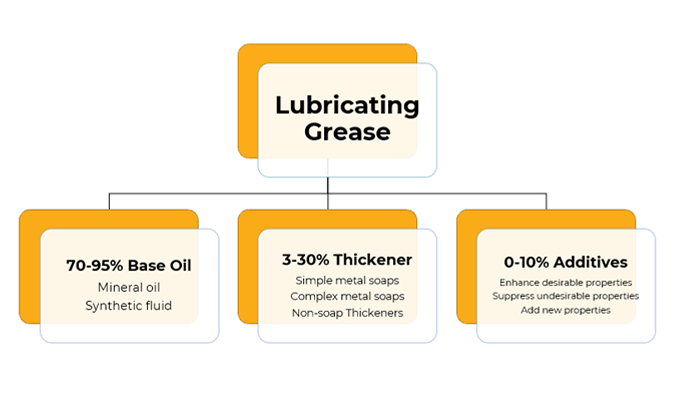The color of grease can indicate its overall quality. Grease can darken as a result of operating and environmental factors. Darkening may be a sign that the grease reached its usability limit.
A change in color can also indicate that one form of grease has combined with another. It is imperative that immediate action be made to determine how and why this occurred. You should be cautious about applying the wrong grease to your machine. For different types of grease, use different fittings, such as standard fittings for stand-alone bearings and button-head fittings for electric motor bearings to avoid contamination. This will take care of your grease discoloration problems. Another option is to leave a mound of grease on the grease fitting to demonstrate the correct color.
Although the color of grease may provide useful information, keep in mind that it is just employed as a label to identify the type of grease. However, no grease color is guaranteed to identify a certain thickening type, even within a single grease manufacturer's selections.
Grease Colors
White, black, blue, red, green, purple, transparent, yellow/golden, and other colored greases are available on the market. Grease colors are the subject of many different impressions and perceptions. Colorants are used by grease manufacturers to aid in the identification of greases and to make them more appealing. While a certain color of grease emerges from a grease gun when another color is intended, users can easily recognize errors in grease being used.
To be more specific, white grease indicates greases for food machinery, and black greases indicate moly/graphite greases for extreme operating conditions. Although there is no hard and fast rule, red may indicate oil in high-temperature situations, blue in cold-temperature situations, and green in environmentally friendly situations.
Grease Whiteners
The most common whiteners used to make grease white are titanium dioxide (TiO2) and zinc oxide (ZnO), both of which are solid powders. Depending on the extent and other chemicals used to create base greases, the proportion of these compounds in lubricating greases can range from 0.5-10 percent or even more.
Different percentages of TiO2 and/ or ZnO were used in lithium, lithium complex, aluminum complex, and calcium sulfonate greases, and the effects of these whiteners on the dropping point, penetration, mechanical stability, anti-wear, storage hardening, and oil separations were evaluated in a recent study.
Liquid Dyes
Dyes are used in very small amounts in greases and should not be a source of concern. Certain color classes, however, might cause environmental and health problems. Depending on the color intensity required, the dye concentration might range from 0.001 to 0.5 percent or more.
Polymers or Tackifiers
Polymers are used to increase the consistency, shear stability, water resistance, adhesion, and tack qualities of grease. Polymers, on the other hand, may have a negative impact on greases' cold temperature and flow qualities.
In the presence of water, both polymers enhanced penetration and showed good mechanical and roll stability in calcium sulfonate grease. Higher polymer concentrations, on the other hand, resulted in poor water spray-off qualities
The pumpability of several grease samples was also examined in accordance with the United States mobility test. At 77 degrees F, there was no significant difference in pumpability with or without polymers.
Environmental Factors: Sunlight, Heat, and Water
Due to application requirements or when containers are not maintained in optimum circumstances, it is vital to examine the environment to which grease is routinely exposed, including exposure to sunshine, heat, and water. When grease is exposed to light, its color fades and it no longer has the same visual appeal as when it was manufactured/packaged.
When grease is exposed to heat or high temperatures, it turns dark or turns a dull/light color. Furthermore, the color of grease tends to darken over time when applied. The color of grease is also affected by the presence of water. Red grease, for example, emulsified and changed color from red to orange after floating in water for 24 hours. As a result, the color of grease has little bearing on its overall performance when applied.
Analyzing Used Grease Samples

Changes in Grease
Contamination, oil loss, and mechanical shearing can cause grease to harden or soften in service. If you observe changes, talk to CRE consultants and analysts to help you determine what could be the possible causes of these issues and determine what is the best course of action.
Grease Analysis to Determine the Condition of Grease and Equipment
FTIR Spectroscopy
Fourier transform infrared (FTIR) spectroscopy identifies the type of base oil and thickener of the used grease. By comparing the unused fresh grease reference to the used grease sample, additive depletion or contamination by another grease type can be determined.
In comparison to FTIR spectroscopy of oil, the measurement and interpretation of a grease spectrum are more complex. The thickener compounds can be very dominant within important areas of the spectrum that are normally used for the calculation of the water content or oxidation. FTIR spectroscopy is based on the principle that the molecules present in a lubricant can absorb infrared light at corresponding wavelengths depending on its typical structure. Additive degradation may be seen if a grease contains high-pressure additives. A fresh grease comparison might also reveal whether too much water is present.
Dropping Point
The stability of grease can be compromised as they age. For application, the grease must have a minimum dropping point, according to the OEM. When the temperature is increased, they don't melt like butter or coconut oil, but they don't alter much as the temperature rises since the thickener keeps the base oil stable. The soap structure dissolves only when the thickener's critical temperature is achieved.
When conducting the Dropping Point test, samples are heated until liquid melts and drops into a test tube. Grease samples that melt at temperatures greater than 300 degrees Celsius are not considered to have a dropping point.
Oil Bleeding Test
To properly lubricate a bearing, a grease must release part of its oil during operation. Grease oil bleed rates for bearing lubrication are typically 1 to 5%. The bleed rate is influenced by the viscosity of the base oil and the operating temperature, which should be high enough to ensure appropriate bearing lubrication.
Analytical Ferrography
Using a ferrogram slide maker, analytical ferrography begins with the magnetic separation of machine wear debris from the lubricating oil in which it is suspended. To improve particle precipitation and adhesion, the lubricating oil sample is diluted. The diluted sample runs down a ferrogram, a specially prepared glass slide. The ferrogram is supported by a magnetic cylinder that pulls ferrous particles from the oil. Afterward, the particles collected are identified using a microscope.
Penetration Test
The ASTM cone plunger method is frequently used to identify a grease's stiffness, although there are other methods for determining grease mobility, such as rheological testing with equipment that applies a varied load to grease samples. The ASTM cone plunger method is frequently used to identify a grease's stiffness, although there are additional methods for determining grease mobility.
These various methods can provide extra information, such as the yield point, which can be connected with the ASTM penetration, while also needing fewer samples. The yield point is the minimal force required to induce flow or the point at which the grease transitions from an elastic to a fluid state.
Source: machinerylubrication.com


